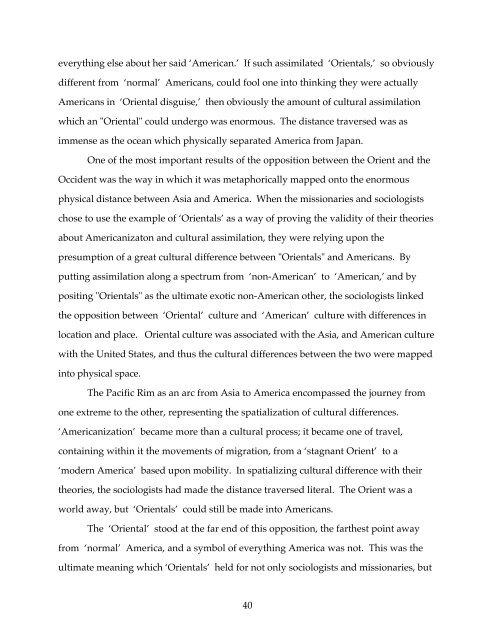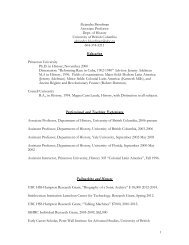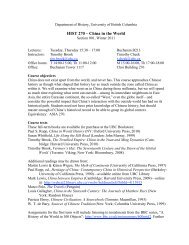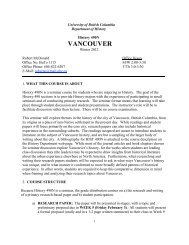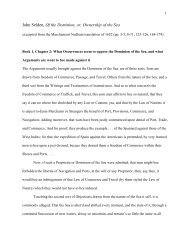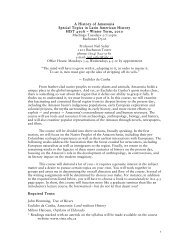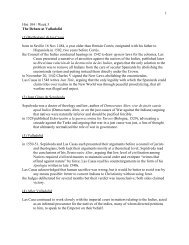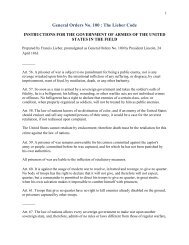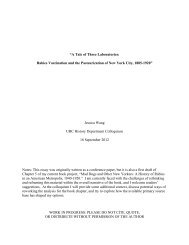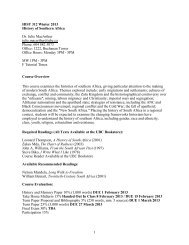Orientalizing the Pacific Rim: - History, Department of
Orientalizing the Pacific Rim: - History, Department of
Orientalizing the Pacific Rim: - History, Department of
Create successful ePaper yourself
Turn your PDF publications into a flip-book with our unique Google optimized e-Paper software.
everything else about her said ‘American.’ If such assimilated ‘Orientals,’ so obviously<br />
different from ‘normal’ Americans, could fool one into thinking <strong>the</strong>y were actually<br />
Americans in ‘Oriental disguise,’ <strong>the</strong>n obviously <strong>the</strong> amount <strong>of</strong> cultural assimilation<br />
which an "Oriental" could undergo was enormous. The distance traversed was as<br />
immense as <strong>the</strong> ocean which physically separated America from Japan.<br />
One <strong>of</strong> <strong>the</strong> most important results <strong>of</strong> <strong>the</strong> opposition between <strong>the</strong> Orient and <strong>the</strong><br />
Occident was <strong>the</strong> way in which it was metaphorically mapped onto <strong>the</strong> enormous<br />
physical distance between Asia and America. When <strong>the</strong> missionaries and sociologists<br />
chose to use <strong>the</strong> example <strong>of</strong> ‘Orientals’ as a way <strong>of</strong> proving <strong>the</strong> validity <strong>of</strong> <strong>the</strong>ir <strong>the</strong>ories<br />
about Americanizaton and cultural assimilation, <strong>the</strong>y were relying upon <strong>the</strong><br />
presumption <strong>of</strong> a great cultural difference between "Orientals" and Americans. By<br />
putting assimilation along a spectrum from ‘non-American’ to ‘American,’ and by<br />
positing "Orientals" as <strong>the</strong> ultimate exotic non-American o<strong>the</strong>r, <strong>the</strong> sociologists linked<br />
<strong>the</strong> opposition between ‘Oriental’ culture and ‘American’ culture with differences in<br />
location and place. Oriental culture was associated with <strong>the</strong> Asia, and American culture<br />
with <strong>the</strong> United States, and thus <strong>the</strong> cultural differences between <strong>the</strong> two were mapped<br />
into physical space.<br />
The <strong>Pacific</strong> <strong>Rim</strong> as an arc from Asia to America encompassed <strong>the</strong> journey from<br />
one extreme to <strong>the</strong> o<strong>the</strong>r, representing <strong>the</strong> spatialization <strong>of</strong> cultural differences.<br />
‘Americanization’ became more than a cultural process; it became one <strong>of</strong> travel,<br />
containing within it <strong>the</strong> movements <strong>of</strong> migration, from a ‘stagnant Orient’ to a<br />
‘modern America’ based upon mobility. In spatializing cultural difference with <strong>the</strong>ir<br />
<strong>the</strong>ories, <strong>the</strong> sociologists had made <strong>the</strong> distance traversed literal. The Orient was a<br />
world away, but ‘Orientals’ could still be made into Americans.<br />
The ‘Oriental’ stood at <strong>the</strong> far end <strong>of</strong> this opposition, <strong>the</strong> far<strong>the</strong>st point away<br />
from ‘normal’ America, and a symbol <strong>of</strong> everything America was not. This was <strong>the</strong><br />
ultimate meaning which ‘Orientals’ held for not only sociologists and missionaries, but<br />
40


